
Amanda DeLouise
TRIGGER WARNING: Topics discussed here will be related to Domestic Violence and Sexual Violence. Throughout, often either or both of these will be referred to as “this violence” so as to minimize repetitive emotional microtraumas for potential victims who may be reading. This content may be triggering or hard to read. Please take care of yourselves.
Disclaimer: Much of the language used here stays within the gender binary. This is because most information out there on this topic is presented within the gender binary, as well as because of the historical socialization of bodies within the gender binary. I recognize the analytical limitations of this framework. It is important to note that there are more than two genders and people who identify or present outside the binary are at greater risk of victimization.
Women as Commodities
For centuries, there have been struggles for the competing repression and liberation of women. A group which branches from the Transformative Consumer Research argues:
“Women have historically been and still are considered the property of men and as such, are often treated as commodities. Commoditization theory contends that a human being can be transformed into a commodity when they become the unit under the control of another [Kopytoff 1986]. The commoditized person is used to achieve the commoditizer’s objectives and is stripped of free will, self-determination and self-hood [Hirschman and Hill 2000]. The commoditized person’s body, skills, abilities, labor and even reproductive capacity are no longer under his or her own control, but rather are controlled by the commoditizer [Hirschman and Hill 2000]” (Transformative Consumer Research).
Women very easily fit into this definition, having been treated and seen in both society and the law as property of men. Silvia Federici asserts in the introduction of her book Caliban and The Witch that “the body has been for women in capitalist society what the factory has been for male wages workers; the primary ground of their exploitation and resistance, as the female body has been appropriated by the state and men and forced to function as means for the reproduction and accumulation of labor” (Federici, 16).

Throughout history, women have been expected to have children and take care of those children while also taking care of the home while the men in their lives work and oversee the home and the members of the family. Without women having and caring for children the system would collapse, because new people means new workers, but someone has to take care of these little people until they are able to become workers. That responsibility has often fallen on women.
Federici elaborates on the changes women faced regarding their sexuality, from prostitution being legal and seen as a public service to the legalization of rape as long as the woman was poor. She also talks about the influence that the church had in the subordination of women: “The clergy recognized the power that sexual desire gave women over men, and persistently tried to exorcise it by identifying holiness with avoidance of women and sex” (Federici, 37). This process was done to break down the power of women and their perceived erotic influence over men, and to implement a patriarchal power structure. The church still has a heavy social and political influence today, which can be seen in religion-based legislation regarding women’s sexuality and reproduction, making way for sexual and domestic violence being used today as a way to continue to control and subordinate women.
The Transformative Consumer Research developed research around the historical treatment of women as commodities rather than people. They argue that this commodification had led to the dehumanization of women by all people, and that “others’ depersonalization of women make it easier to rationalize their abuse both by perpetrators and bystanders” (Transformative Consumer Research). This rationalization results in a never-ending cycle of abusing women and blaming them for being abused, and even the assumption that women exist for that purpose. Women have been and still are considered to be the property of the men in their lives, be it their fathers, husbands, or boyfriends, and since men are the ones in power, and it is seen as okay for men to exert that power “by any means necessary” (angola3news).
Some more extreme ways that women are commodified are through forced marriage and human trafficking where there is a tangible price tag attached to the women being bought and sold; also when women are raped, they are violated and literally used and discarded by the perpetrator. There are also more subtle ways this presents itself, such as casual sexual harassment such as “sexual innuendo, catcalls, and inappropriate touching because men who sexually harass believe they have the right to comment on and have access to women’s bodies. Portrayals of women as sexualized objects in media, advertisements and pornography also contribute to thinking of women as commodities” (Transformative Consumer Research).
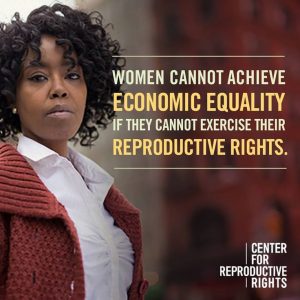
Another form of violence are the constant attempts at restricting and eliminating reproductive healthcare and access to safe abortions, because women are expected to have children. When previously women had control over their reproduction, Federici says that “the witch hunts demonized any form of birth-control and non-procreative sexuality, while charging women with sacrificing children to the devil” (Federici, 88). Women became obligated to procreate in order to maintain the labor force. By demonizing them for exercising power over their own reproduction, it became much easier for men to control and subordinate women.
To this day, women are subjected to being treated as objects simply for existing, in public space and in the private sphere. Whether it be from strangers on the street, the television screen, or loved ones, most women learn from a young age that they are not seen as people, but as objects, as toys, as vessels for the use of others, particularly men. It is no surprise then that women and people assumed to be feminine would be subject to high rates of violence, because their bodies are seen to exist as property to be used and discarded.
Gender-Based Violence
Sexual violence and domestic violence are much more similar than they are different. The root causes are the same. The perpetrators and the victims tend to be the same. They have similar effects on victims and satisfy similar voids for perpetrators: a craving for power and control. Because of the multitude of similarities and connections between sexual and domestic violence, I often refer to them together, however I recognize that they are not one and the same.

RAINN.org defines rape as “the unlawful penetration of a person against the will of the victim, with use or threatened use of force, or attempting such an act. Rape includes psychological coercion and physical force, and forced sexual intercourse means vaginal, anal, or oral penetration by the offender. Rape also includes incidents where penetration if from a foreign object (e.g., a bottle), victimizations against male and female victims, and both heterosexual and homosexual rape.”
RAINN.org defines sexual assault as being “across a wide range of victimizations, separate from rape or attempted rape. These crimes include attacks or attempted attacks generally involving unwanted sexual contact between a victim and offender. Sexual assault may or may not involve force and includes grabbing or fondling.
Domestic Violence occurs in the family unit, whether it be parent-child, child-child, or partner-partner. Physical abuse is the most noted form of domestic violence, but it is not the only. Some other forms of domestic violence include verbal abuse, psychological abuse, emotional abuse, financial abuse, and sexual violence (Pearl). Some signs of an abusive person include but are not limited to: keeping tabs on you constantly; isolating you from friends and family; threatening or intimidating you; destroying your possessions; threatening your pets or loved ones (Brown).
The Victims of This Violence are Overwhelmingly Women

It is estimated that 4.5 million people are forced into human trafficking and sexually exploited; 98% of these victims are women and girls (Transformative Consumer Research). 85% of domestic violence victims are women and 15% are men (Vagianos); 90% of rape victims are women and 10% are men (RAINN.org). The perpetrators of this violence against all genders are most often men.
In the United States, 1 in 4 women and 1 in 7 men will be victims of severe violence by an intimate partner in their lifetime; this number increases for gay and bisexual men, to 2 in 5. (Vaginaos). One out of every 6 women and one out of every 33 men has been a victim of rape or attempted rape in their lifetime (RAINN.org). In addition, 40-45% of women in physically abusive relationships are also raped and/or assaulted during the relationship (Vaginaos). In Mexico, 6 out of 10 women experience some form of gender-based violence; Mexico has some of the highest numbers of gender-based violence and femicides (teleSUR English).
“Black women experience intimate partner violence at rates 35% higher than white women” (Vaginaos). “American Indians are twice as likely to experience sexual violence compared to all races” (RAINN.org). “Women with disabilities are 40 percent more likely to experience intimate partner violence—especially severe violence—than women without disabilities” (Vagianos). Marginalized groups are at high risk of violence because of their perceived vulnerability or weakness, or the idea that they are inferior because they have been otherized. It is easy for perpetrators to feel a sense of control by exerting power over people they may have social power over. This can make the most marginalized people, such as people of color, immigrants, low-income and houseless people, and disabled people face victimization at higher rates. In addition, Native Americans are more likely to be assaulted by strangers, whereas overall statistics show a propensity towards victims knowing the assailant in some way (RAINN.org). This shows how race and gender intersect, being that women of color often face violence for being their gender and their race simultaneously.
Transgender, queergender, and gender-nonconforming people also face higher risks of sexual and domestic violence. Twenty-one percent of transgender, queergender, and nonconforming (TGQN) college students have been sexually assaulted; those rates decrease slightly to 18% for non-TGQN females and drastically to 4% for non-TGQN males (RAINN.org). TGQN people of color face even higher rates of violence than their white peers. A transgender person of color is 2.6 times more likely to become a victim of domestic violence than a non-LGBT person (Vagianos).
Children and Juveniles

Ten million children are exposed to domestic violence in the United States every year (Vagianos). Children being exposed to abuse in the home are likely to carry over those experiences into their lives in negative ways. Juveniles are also at the highest risk of sexual violence, juvenile girls in particular: 82% of all juvenile victims of sexual violence are girls and 18% are boys (RAINN.org). Of CPS claims that are substantiated or in which supporting evidence is found, 88% of the time the perpetrator is a man, 9% of the time they are female, and 3% are unknown; also, 80% of the time the perpetrator was found to be a parent of the child (RAINN.org). Children are easy to control and manipulate, making them easy targets for all forms of abuse. Children are also seen as more “pure” and innocent but are also sexualized from a very young age. All of this and more makes children, our most vulnerable population of people, at high risk for sexual and domestic violence.
The Cost of Abuse

Pursuing legal action against a perpetrator is expensive for all parties involved. Lawyers, court proceedings, loss of work, and so much more. In the majority of cases, reported assaults do not result in a conviction or jail time for the accused. In addition to legal costs, domestic violence costs $8.3 billion in expenses annually, including medical costs and loss of productivity (Pearl)
Medical Costs
Medical costs due to domestic violence make up $5.8 billion dollars annually. Abuse victims are more likely to experience psychological challenges, such as Post-Traumatic Stress Disorder (PTSD) and anxiety. They are also more likely to experience long-term health complications related to abuse, such as heart disease, stroke, and asthma (Pearl). Victims visit doctors, hospitals, and counselors more often due to immediate and lasting physical and psychological injuries (Avellana), costs which fall onto individuals as well as facilities. There are 18,500,000 mental health care visits every year due to this violence, and the difference in average cost for emergency care for incidents related to this violence is staggering: the cost for women is $948, while the cost for men is $387 (Vagianos). Healthcare costs are 42% higher for abused women than non-abused women, and women with recent non-physical abuse had annual costs higher than non-abused women at a 33% higher rate (Futures Without Violence).
Loss of Productivity
Abuse results in an annual $2.5 billion loss in productivity (Pearl). Women lose 8,000,000 days of paid work every year due to abuse perpetrated by current or former male partners (Vagianos). Victims of abuse tend to have to take more time off of work and school for doctor and hospital visits, counselor visits, and legal visits and proceedings. Ansuya Harjani wrote an article for World Economy outlining some of the economic costs of this violence. Harjani calls attention to how abusive partners use tactics to interfere with the victim’s employment, such as restricting or manipulating transportation, and not following through with childcare plans. Harjani also articulates how experiencing this violence is associated with increased tardiness and use of days off, as well as “problems with concentration, job performance, and productivity” (Harjani). Sometimes abuse victims are asked to leave their jobs or have been fired because they are being stalked (Futures Without Violence).
Leaving is Expensive
Being childless, leaving an abusive partner is difficult. If you are a parent suffering from abuse, leaving presents even more challenge because: of the feared negative affects it will have on the children; it is difficult to move around with children at all, let alone when you are trying to flee for safety; guilt and embarrassment for “taking their kids away.” In addition, the occurrence of financial abuse in domestic violence situations is 98% (Vaginaos) . “The number one reason domestic violence survivors stay or return to the abusive relationship is because the abuser controls their money supply, leaving them with no financial resources to break free” (Vaginaos). Often time women in abusive situations are pressured into childbearing and into being a housewife or part time worker, restricting their access to financial resources and social networks. All this on top of having to now pay all expenses on their own with little time or ability to prepare can often lead to houselessness.
Melissa Jeltsen states that domestic violence is the third-leading cause of homelessness among families. She also shows how houseless abuse victims need special considerations: “Families that become homeless due to domestic violence often face challenges that other homeless populations may not have to confront..they may require critical safety measures, such as a confidential location, and it’s likely they will need trauma support. There is also the unfortunate reality that people sometimes stay with an abuser because they don’t have access to the money they need to get them into a safer situation” (Jeltsen). It is less safe for women to be houseless than men due to exposure and likelihood of violence.
Law Enforcement

It is estimated that only approximately one-third of sexual assaults are reported to the police (RAINN.org). From 2005 to 2010, victims gave the following reasons for not reporting sexual crimes to the police: “20% feared retaliation; 13% believed the police would not do anything to help; 13% believed it was a personal matter; 8% reported to a different official; 8% believed it was not important enough to report; 7% did not want to get the perpetrator in trouble; 2% believed the police could not do anything to help; 30% gave another reason, or did not cite one reason” (RAINN.org).
Many people do not trust the police, especially not in regards to gender-based violence. A contributing factor of this could be because of the high rates of domestic violence reported in relationships involving a police officer. Studies show that 24-40% of police officer families experience domestic violence, and it is been shown that within departments fellow police officers cover up the abuses of their peers (National Center for Women and Policing). Police often ask victims what they wore, what they drink, who they were with, and other questions which place blame onto the victim. Police also exhibit aggressive tendencies and police brutality is a growing epidemic in the US. It is hard to blame people for not trusting the police.
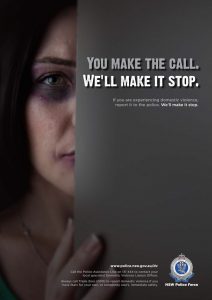
“Prisons and policing often protect those in power, and do very little to nothing…for those who don’t have any power” (angola3news 2011). For most people, the police are not there to protect them. Police also may pick and choose when they decide to interact or intervene, and when they do interact it can result in more violence than before they came. In many communities, police are not seen as “protectors”, and a woman calling the police and inviting them into their community can result in her being ostracized from the rest of the community.
Community members may see her as calling the police in to “further terrorize” the community, and so she risks losing support from friends, family, and neighbors that she made have gotten had she not called the police. That aside, the police being called does not mean the abuse will even stop. The police may end up arresting the abuser who may then spend a night in jail, but that does little to actually stop the abuse long-term. Police may also pressure the abused to file charges, often using threats to take children, amongst other things (angola3news, 2011).
Fighting Back
So often women are asked why they stay, why they don’t leave; told what to do and how to do it by people who often have never been in the same situation. With so much blame placed on women for their victimization, and so many excuses given to perpetrators, it stands to reason that at some point, women would believe it is their fault also. So they stay, they try to make it work, they fight for love and their families. There are not many other options widely presented.
In the United States, it is pretty clear that sexual assault is not taken seriously, considering the current president publicly bragged “about sexual assault and dismissed this as ‘locker room talk,’ has been accused by more than a dozen women of groping or sexual assault, and has expressed his intention to restrict access to legal abortion and reproductive health services, which would pose grave risks for all women” (Avenue). Women are told not to report their abusers because the abuser’s career might be ruined, and women are accused of lying about abuse in an attempt to bring harm to the abuser’s self or employment and social opportunities. This election has blatantly confirmed that assault allegations cause very little harm to the accused. Yet somehow the responsibility is consistently placed on the shoulders of the victim to keep quiet and protect their abusers.
Women are at risk for even more violence when they do leave abusive situations. “A woman is 70 times more likely to be murdered in the few weeks after leaving her abusive partner than at any other time in the relationship” (Vagianos). Staying is risky, leaving can be even riskier. Leaving is nearly impossible when you do not have financial resources, or you have been isolated and have no support system or social resources, especially when you have children involved. It is never a matter of just leaving. Thankfully, there are many ways in which people are standing up and resisting this violence for themselves, their loved ones, and all victims and potential victims.
Quiet Resistance
When most people think of resisting abuse, they think of physically fighting back, screaming for help, “by any means necessary.” Martine Renoux, a Senior Psychotherapist and Counselor, details in a video how abuse victims resist in smaller, but just as significant ways. Renoux defines resistance as “any effort to stop, limit, or prevent violence and abuse, and it’s also any effort to defy violence and abuse.” She asserts that seemingly insignificant, less obvious ways of resisting are just as important and just as valuable as more overt resistance. Renoux wants people to start completely assuming that people resist, because “no victim is passive, ever” (Renoux).

Renoux explains how the expected, more “provocative” forms of resistance is limiting for abuse victims, as is the assumption that “if you didn’t stop it, you didn’t resist” (Renoux). This form of overt resistance often leads to further violence and the assumption that the victim provoked a response from the abuser and thus the victim is blamed and told they shouldn’t have done whatever they did to provoke the reaction: all further perpetuating a cycle of violence. These situations are seen as mutual violence, “an argument that went wrong” (Renoux). Renoux makes clear that “an argument is two people doing it” and that victims do not ask for or participate in violence by resisting the violence.
Renoux suggests asking different questions, such as what victims did, what they were thinking, what did they try, because in almost all cases, the victim did something, no matter how little, to resist the violence they faced. Asking these different questions creates in a victim a shift of perception which allows them to focus on all that they did do instead of all that they didn’t do to stop the violence. This shift can be empowering for victims and help them to realize it was not their fault and they did what they could do in a bad situation.
Resisting Out Loud
The International Day for the Elimination of Violence Against Women is November 25. “The date was chosen to commemorate the Mirabal sisters—three political activists that were ordered to be brutally assassinated by Dominican Republic ruler Rafael Trujillo in 1960. People around the world come together in solidarity on this day to protest violence against women and gender-based violence (Harjani).
Ni Una Muerta Más – Argentina
During the 1990s, Susana Chavez protested through her poetry the violence against women that was occurring in her hometown of Ciudad Juárez. In 1995, she wrote “Ni Una Menos, Ni Una Muerta Más” which translates in English to “Not One Woman Less, Not One More Death.” Susana Chavez never had the chance to see how much of a symbol her words would become, because she was sexually and physically abused by three men before they suffocated her in January 2011 (Muñoz Padrós).
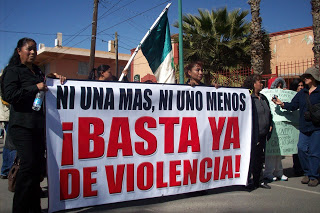
In 2016, protesters in Argentina borrowed Chavez’s words to champion their fight towards ending violence against women. On October 8, 70,000 people attended the celebration of Argentina’s 31st National Women Encounter in Rosario. During this event, a 16-year-old girl named Lucia Perez was a victim of brutal violence before being killed in Mar de Plata (Muñoz Padrós, A.). Eighty-thousand people hit the streets of Santiago on October 19, 2016. This was the day of the first women’s strike in Argentina, which was supported by Mexico and Bolivia, followed by other countries such as Chile and Peru. Their goal with this demonstration was to say loud and clear “Not One Less” and to bring attention to femicide, violence against women, and the need for free abortion. Others in attendance also advocated for stopping forced sterilization of women. The organizers wanted to “create awareness and to promote a cultural change..because Chile is a very conservative country. It takes a lot for women to speak out” (Muñoz Padrós). For this event, a dress code was implemented: all-black clothing, to mourn the victims of femicides. Even people who were unable to attend the protest were seen in large numbers wearing all black as a show of solidarity to the protest.
Don’t Shut Up – Mexico
After being sexually assaulted, three women in Mexico organized a protest which they called “Don’t Shut Up.” This event was a call to action in response to the high rates of rape and sexual assault against women in Mexico. The organizers assert that “the most powerful weapon of sexual aggressors is our silence” (teleSUR English) and so they want victims to speak out. They want victims to share their stories, and find strength in their truth and knowing it was not their fault. They said they do not want attention, they want change; they want women to stop being victimized, and they especially want women to not feel pressured to remain silent afterwards. The organizers argue that sexual abuse happens because violence becomes the norm. We blame victims and excuse perpetrators, asking questions about what the victim did or said or wore or drank, all somehow seen as bigger factors than why the perpetrator acted the way they did. The organizers recognize that “women aren’t able to move freely” and the first step in changing that is ending the silence (teleSUR English).
Women’s March – USA

The Women’s March in January 2017 brought together many women (albeit catering to certain groups of women) to advocate against the new president’s sexist and violent remarks about women and to advocate for access to reproductive healthcare and safe abortion. There are also annual Slut Walks, which use shock factor by wearing little clothing, bringing people together to protest the sexualization and objectification of the female body, as well as violence against women and victim-blaming.
There has been more of an emphasis on teaching women and girls self-defense as a means to defend themselves if they are to be victimized. These classes are being offered in more colleges and universities, as well as through different grassroots organizations. However, teaching self-defense does not stop violence from happening, it just aims to assure that individual isn’t the victim of it. Daniel Carter, a Campus Safety Advocate, says that we need to change the culture of allowing and excusing violence, which allows perpetrators to keep reoffending and keep creating more victims (Taboh).
Standing Together
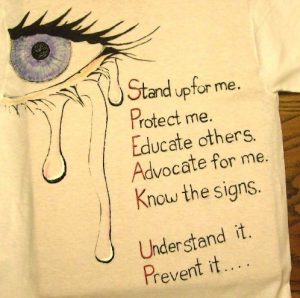
The hardest times become a little less hard when you have a community and a support system on your side. Sometimes even just knowing there are people out there working towards changing this culture of abuse and violence can provide a sense of solace and resilience to victims. Sexual and domestic violence happens to so many people; it can be so helpful for victims to know they are not alone, there are people who care, their feelings and their struggles are valid and real and important. In addition to communities coming together to support each other and support victims of this violence, there is also more knowledge and information being distributed and circulated than there has been in the past. People are talking about it more, people are sharing their stories more often and more publicly, and the first step towards solving a problem is stating that there is one. Silence does not protect victims, silence protects perpetrators, and it is time that we as a society start listening to and supporting victims of sexual and domestic violence.
There is Strength in Your Story
As more people share their experiences with this violence, more people feel comfortable coming forward and sharing their own. Most victims hide their abuse, they suffer in silence: they fear being blamed or not believed. Cassie Edwards, a sexual assault victim, shares her story and has since reached out to other rape victims. She says “I think me talking helps other victims see that, you know, it’s not something that you should be ashamed of” (Taboh).
Education and Prevention
In their journal “The Effect of a College Sexual Assault Prevention Program on First-year Students’ Victimization Rates,” Emily Rothman and Jay Silverman found that exposure to sexual assault prevention programs “was associated with a reduction in the reported prevalence of sexual assault victimization (12% among those exposed, 17% among those unexposed)” (Rothman & Silverman). This shows that education and knowledge can result in a decrease of rates of victimization.
Beauty Professionals in Illinois
An article on The Guardian showed that in Illinois, beauty professionals are being trained about local domestic violence resources and anti-DV information in an attempt to more easily distribute that information to potential victims who may not have access to those resources otherwise. Beauty professionals get close to their clients and may see or notice things that resemble injuries that may not ordinarily be recognizable, or clients may disclose something that gives the impression that abuse could be occurring. The purpose of this training is not to provide counseling or therapy for clients, but rather to give them the opportunity to obtain information on help that is out there. Professionals can provide phone numbers or get clients in contact with a shelter, or give them information about domestic violence. All of this is up to the client, and they have the choice whether or not they get this information or do anything with it. Also, professionals are not required to bring any information to the police unless they choose to.
New Destiny Housing in The Bronx, New York

New Destiny Housing is a non-profit in New York City that provides low-income rental housing with the specific goal of assisting domestic violence survivors. It has 11 sites which serve to assist survivors coming out of the shelter system, with approximately 50% of tenants being survivors while the other 50% is other low-income people; tenants pay around 30% of their income towards rent. The purpose of this housing opportunity is to allow for a focus on what happens after victimization and how to instill in survivors a sense of long-term safety and stability (Jeltsen).
These complexes have a heavy presence of security cameras in varying angles of the buildings, and survivors who move in work with on-site staff members to develop a safety plan in case of emergency or their abuser locating them. Beyond providing security, staff members also “offer counseling, employment coaching, workshops on financial literacy and referrals to specialists who can help women with legal assistance and job training” (Jeltsen). These resources are provided in an attempt to remedy the many additional challenges that victims of this violence face, and to allow them to navigate a very difficult situation with a little bit of help and information.
Victims of domestic violence often experience intense isolation and have little to no support system or social network to help them, often a result of the abuser’s controlling and possessive behavior. The housing opportunities that New Destiny Housing provides allow for victims to establish “a sense of an open, communal environment where people get a chance to know their neighbors” and make connections with other people (Jeltsen) and it has shown positive results for residents. This system of community and support can make a drastic difference in how victims are able to navigate dealing with the trauma they endured by providing them a sense of normalcy. Safety and security paired with community and support are a huge step towards making survivors feel like they can move on from their trauma and reassure them that a better life is possible.
Women in Law Enforcement
The National Center for Women and Policing (NCWP) is a program of the Feminist Majority Foundation and is working towards instituting more gender-balancing in law enforcement agencies. This program has been working towards educating policy makers, the media, and the public about the associated benefits of women in policing since 1995. NCWP “promotes increasing the numbers of women at all ranks of law enforcement as a strategy to improve police response to violence against women, reduce police brutality and excessive force, and strengthen community policing reforms” (Harrington & Moore).
Over 20 years of research have shown that the policing style of women officers tend to rely “less on physical force, and more on communication skills that defuse potentially violent situations” which results in fewer occurrences of police brutality. Calls regarding violence against women are the most frequent calls to police in the United States, and research also showed that women police officers are far more likely to respond to calls regarding violence against women in an effective way than are men officers (Harrington & Moore). Women officers responding more through communication and less through force could be due to female socialization as passive nurturers and caregivers. Women are tasked with expending a large amount of emotional labor throughout their lives, and that socialization often carries over into their working lives.
Although there is much evidence to show that women in law enforcement produces positive outcomes, the most recent survey by NCWP shows that women still only represent 13% of police officers nationwide. Discriminatory hiring and selection practices play a large part of this discrepancy (Harrington & Moore). Unfortunately, policing is a male-dominated field and police officers are expected to be more enforcers than nurturers, leaving little room for soft-hearted officers who would rather communicate than brutalize, regardless of gender.
Community Defense
In the face of police brutality, communities have come together to form their own coalitions for protection. In Harlem, New York, residents formed “neighborhood watches” to protect women who were being abused. When a complaint was made by an abuse victim or a concerned neighbor, a few people would go to the homes where the situation was occurring and physically move themselves in for a few days. While they knew they could not stay there long term, the abusive partner would know their behavior could not continue while people were there, and that once they left they would still be watching and ready to come back if necessary (Angola3news). The community came together and decided they would not stand for the violence and abuse anymore, from police or between members of the community.
SISTA 2 SISTA was another community coalition formed to address interpersonal violence and state violence. Women in this group formed what were called Sister Circles. Women in the community knew they could not rely on police who come into their communities and murder people. They came together to discuss how to address abuse without relying on policing and prisons; there was a lot of talking and a lot of planning. In one situation, a few women decided to confront a woman’s abuser in his place of work to demand that he stop his abusive behavior. His coworkers spoke up and said it needs to stop, and his boss said if he heard about it again, that the abuser would be fired (Angola3news).
Self-Defense
Cell Block 16 formed in the 1960s and ’70s in Boston, Massachusetts. Groups formed to patrols areas where working-class women were getting out of factory shifts late at night because they understood that women with less resources are more vulnerable to violence. They patrolled in pairs or groups, offering to walk women to wherever they were going. The goal was to make sure women were safe from external threats, with the idea that there is safety in numbers. Together they watched out for suspicious behavior, putting potential assailants on notice that people were watching out for eachothers safety. Cell Block 16 was also the first to offer feminist self-defense classes: they believed that women have a right to feel safe and secure in their own bodies as well as being capable of physically defending themselves if they are attacked and not have to rely on others to defend them (Angola3news).
The Center for Anti-Violence Education (previously Brooklyn’s Women’s Marshall Arts) offered classes for women on a sliding scale, so women paid what fit their ability, making the opportunity more accessible. They also offered childcare so women with children could come and have a place to leave their children that they knew would be safe; mothers are just as, if not more, vulnerable than women without children. Their name ultimately changed because they recognized it was not only women at risk for this violence and that other vulnerable populations should be able to defend themselves as well such as transgender people. They also worked with other organizations that serviced South Asian populations in post-9/11 tensions (Angola3news).
In addition to teaching self-defense skills, the Center for Anti-Violence Education taught tactics for deescalation, knowing what to look for to prevent or minimize situations before they occur, and how to confront situations without using fists or violence. They also recognized that violence held different types of oppression together, and that women with the least amount of resources are most vulnerable to violence in interpersonal relationships as well as from the state and the police. “There are all these different oppressions that intersect, and then you can see violence as one of the glues that hold together all this violence” (Angola3news).
Changing the Conversation
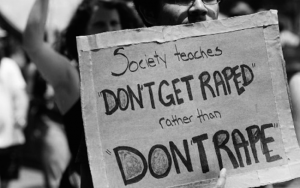
Transformative Consumer Research facilitated a collaborative effort to change the focus from victims to focusing on men, who are the main perpetrators of this violence. They aim to change the culture of blaming victims and asking why they were raped to a culture of blaming perpetrators and focusing on why they rape. While recognizing that empowering and educating women is necessary, their framework focuses on “understanding men, their mindsets and cultural practices that reproduce and reinforce the perpetuation of violence against women with the ultimate goal of change” (Transformative Consumer Research). Focusing on the people who are victimized rather than focusing on the people who are victimizing ultimately places blame and responsibility on victims, so Transformative Consumer Research set out to explore violence against women and the ways in which it is perpetuated through a three-step collaborative conference.
There are media campaigns, such as It’s On Us which aim to teach people to not be bystanders, and to speak out against sexual and domestic violence (Taboh). People are expressing themselves, sharing their stories through various art forms such as video, music, dance, painting, drawing, and others. People are also calling attention to how commonly used language is flooded with subtle messages that disparage women and people who are perceived to be feminine as well as victims of sexual and domestic violence. There is more conversation about media that promotes rape culture, and more space for people to speak out about their experiences with abuse. Just talking about it more is a huge step in the right direction, but people are doing more than that, people are coming together to support victims and hold perpetrators accountable.
What Can You Do?
The most basic and arguably most important thing any individual can do to stop the perpetuation of this culture of violence is very simple: when someone tells you they have been victimized, believe them and support them. We need to start approaching this violence with the severity and frequency in which it is perpetrated. Learn to recognize warning signs. If you hear someone making comments or “jokes” that perpetuate the oppression of or violence against women and feminized people, do not just ignore it. Stand up, speak out. If you know someone who has been victimized, reach out, offer support, help them however they need. Just knowing they are not alone and that someone supports them and cares can make all the difference in whether or not someone seeks justice for the violence perpetrated against them.
It starts with us as individuals to change the way we respond to victims’ claims of sexual and domestic violence. We need to change the way we speak, change the way we act, and change the way we see each other. Only we can stop this violence. This can only happen when we start respecting women and feminized people, respecting people with trans and non-binary gender identities, stop restricting reproductive health access, supporting and believing victims, recognizing how systems of oppression intersect, and focusing the conversation on perpetrators’ actions.
Sources
Angola3news. (2011). Vikki law: Resisting gender violence without cops or prisons. YouTube.
Avellana, N. J. (2013, July 11). Violence against women costs you this much money. Huffington Post.
Avenue, H. R. W. (2016, November 28). Mass rapes to mass protests: Violence against women in 2016. Human Rights Watch.
Brown, J.J. (2014, September 12). 8 ways to get help for domestic violence. Everyday Health.
Federici, S. (2004). Caliban and the witch: Women, the body, and primitive accumulation. Brooklyn, NY.: Autonomedia (1st ed.).
Health Care Cost of Domestic and Sexual Violence. (2010, March). Futures Without Violence.
Harjani, A. (2013, November 24). Domestic violence results in huge costs for economy. CNBC.
Harrington, P. &, M., M. (n.d.). National Center For Women and Policing. WomenAndPolicing.org.
Jeltsen, M. (2016, January 14). When women must choose between abuse and homelessness. Huffington Post.
Pearl, R., M.D. (2013, December 5). Domestic violence: The secret killer that costs $8.3 Billion Annually. Forbes.
Muñoz Padrós, A. (2016, December 28). Striking-and fighting-for abortion and an end to violence in Latin America. Ms. Magazine.
National Center For Women and Policing. (n.d.). Police family violence fact sheet. WomenAndPolicing.org.
RAINN.org. (n.d.). Statistics. Rape Abuse & Incest National Network (RAINN).
Renoux, M. (2015, March 13). How survivors resist domestic violence and abuse. AVAproject.
Rothman, E., & Silverman, J. (2007). The effect of a college sexual assault prevention program on first-year students’ victimization rates. Journal of American College Health, 55(5), 283-290.
Taboh, J. (2014, December 17). How US is confronting its sexual assault crisis. VOA News.
TeleSUR English. (2016). We won’t shut up: Sexual violence in Mexico. YouTube.
The Guardian. (2017, January 1). Illinois law turns to hairstylists for help in fight against domestic abuse. The Guardian.
Transformative Consumer Research. (2016). Women as commodities: An examination of violence against women. Transformative Consumer Research.
Vagianos, A. (2014, October 23). 30 shocking domestic violence statistics that remind us it’s an epidemic. Huffington Post.